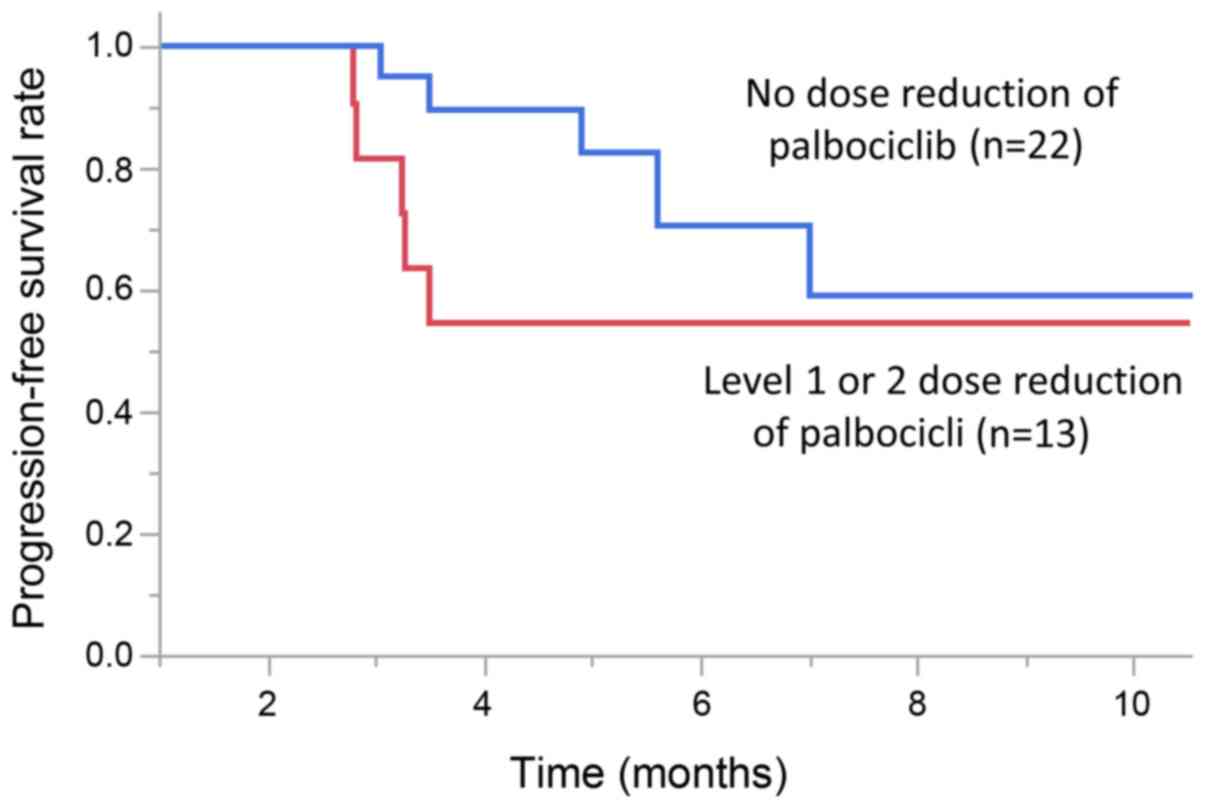|
1
|
Fry DW, Harvey PJ, Keller PR, Elliott WL,
Meade M, Trachet E, Albassam M, Zheng X, Leopold WR, Pryer NK, et
al: Specific inhibition of cyclin-dependent kinase 4/6 by PD
0332991 and associated antitumor activity in human tumor
xenografts. Mol Cancer Ther. 3:1427–1438. 2004.PubMed/NCBI
|
|
2
|
European Medicines Agency: IBRANCE Product
Information. http://www.ema.europa.eu/en/medicines/human/EPAR/ibrance.
|
|
3
|
Pharmaceuticals and Medical Devices
Agency: New drugs approved in September (2017) (In Chinese).
https://www.pmda.go.jp/index.html.
|
|
4
|
Ibrance (palbociclib): Full prescribing
information. Pfizer Inc., New York, 2018. http://labeling.pfizer.com/ShowLabeling.aspx?id=2191.
|
|
5
|
Finn RS, Martin M, Rugo HS, Jones S, Im
SA, Gelmon K, Harbeck N, Lipatov ON, Walshe JM, Moulder S, et al:
Palbociclib and letrozole in advanced breast cancer. N Engl J Med.
375:1925–1936. 2016. View Article : Google Scholar
|
|
6
|
Turner NC, Ro J, André F, Loi S, Verma S,
Iwata H, Harbeck N, Loibl S, Huang Bartlett C, Zhang K, et al:
PALOMA3 Study Group: Palbociclib in hormone receptor positive
advanced breast cancer. N Engl J Med. 373:209–219. 2015. View Article : Google Scholar
|
|
7
|
Tamura K, Mukai H, Naito Y, Yonemori K,
Kodaira M, Tanabe Y, Yamamoto N, Osera S, Sasaki M, Mori Y, et al:
Phase I study of palbociclib, a cyclin-dependent kinase 4/6
inhibitor, in Japanese patients. Cancer Sci. 107:755–763.
2016.PubMed/NCBI View Article : Google Scholar
|
|
8
|
Masuda N, Nishimura R, Takahashi M, Inoue
K, Ohno S, Iwata H, Mori Y, Hashigaki S, Muramatsu Y, Nagasawa T,
et al: Palbociclib in combination with letrozole as first-line
treatment for advanced breast cancer: A Japanese phase II study.
Cancer Sci. 109:803–813. 2018.PubMed/NCBI View Article : Google Scholar
|
|
9
|
Dickler MN, Tolaney SM, Rugo HS, Cortés J,
Diéras V, Patt D, Wildiers H, Hudis CA, O'Shaughnessy J, Zamora E,
et al: MONARCH 1, a phase II study of abemaciclib, a CDK4 and CDK6
inhibitor, as a single agent, in patients with refractory
HR+/HER2- metastatic breast cancer. Clin
Cancer Res. 23:5218–5224. 2017.PubMed/NCBI View Article : Google Scholar
|
|
10
|
Sledge GW Jr, Toi M, Neven P, Sohn J,
Inoue K, Pivot X, Burdaeva O, Okera M, Masuda N, Kaufman PA, et al:
MONARCH 2: Abemaciclib in combination with fulvestrant in women
with HR+/HER2- advanced breast cancer who had
progressed while receiving endocrine therapy. J Clin Oncol.
35:2875–2884. 2017.PubMed/NCBI View Article : Google Scholar
|
|
11
|
Goetz MP, Toi M, Campone M, Sohn J,
Paluch-Shimon S, Huober J, Park IH, Trédan O, Chen SC, Manso L, et
al: MONARCH 3: Abemaciclib as initial therapy for advanced breast
cancer. J Clin Oncol. 35:3638–3646. 2017.PubMed/NCBI View Article : Google Scholar
|
|
12
|
Loibl S, Turner NC, Ro J, Cristofanilli M,
Iwata H, Im SA, Masuda N, Loi S, André F, Harbeck N, et al:
Palbociclib combined with fulvestrant in premenopausal women with
advanced breast cancer and prior progression on endocrine therapy:
PALOMA-3 results. Oncologist. 22:1028–1038. 2017.PubMed/NCBI View Article : Google Scholar
|
|
13
|
Pfizer Internal Materials:
Pharmacokinetics in Japanese healthy adults (single administration)
[L20170116042]. https://www.pfizer.com/science/find-a-trial/search/Ibrance.
|















